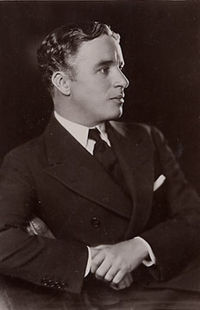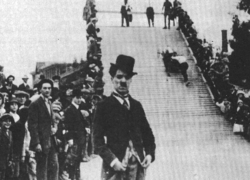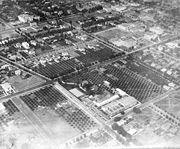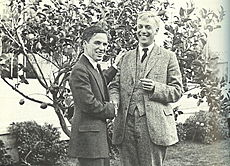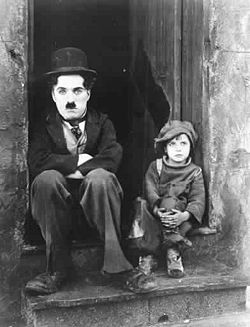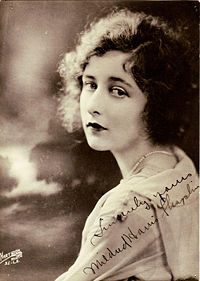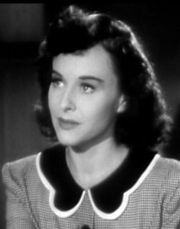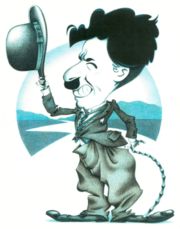Charlie Chaplin
2008/9 Schools Wikipedia Selection. Related subjects: Actors, models and celebrities
| Charles Chaplin | |||||||||||
|---|---|---|---|---|---|---|---|---|---|---|---|
 |
|||||||||||
| Born | Charles Spencer Chaplin, Jr. 16 April 1889 Walworth, London, England |
||||||||||
| Died | 25 December 1977 (aged 88) Vevey, Switzerland |
||||||||||
| Years active | 1914 - 1976 | ||||||||||
| Spouse(s) | Mildred Harris (1918-20) Lita Grey (1924-28) Paulette Goddard(1936-42) Oona O'Neill (1943-77) |
||||||||||
|
|||||||||||
Sir Charles Spencer Chaplin Jr., KBE ( 16 April 1889 – 25 December 1977), better known as Charlie Chaplin, was an English comedy actor. Chaplin became one of the most famous actors as well as a notable director and musician in the early to mid Hollywood cinema era. He is considered to be one of the finest mimes and clowns ever caught on film and has greatly influenced performers in this field.
He acted in, directed, scripted, produced, and eventually scored his own films. Chaplin was also one of the most creative and influential personalities in the silent-film era. His working life in entertainment spanned over 65 years, from the Victorian stage and music hall in the United Kingdom as a child performer, almost until his death at the age of eighty-eight. Chaplin's high-profile public and private life encompassed highs and lows with both adulation and controversy.
His principal character was " The Tramp" (known as "Charlot" in France and the French-speaking world, Greece, Italy, Portugal, Romania, Spain and Turkey, and as "Carlitos" in Brazil). "The Tramp" is a vagrant with the refined manners and dignity of a gentleman. The character wears a tight coat, oversized trousers and shoes, and a derby; carries a bamboo cane; and has a signature toothbrush mustache.
Childhood
Charlie Chaplin was born on 16 April 1889, in East Street, Walworth, London. His parents were both entertainers in the Music Hall tradition; they separated before Charlie was three. He learned singing from his parents. The 1891 census shows that his mother, the actress Lily Harvey ( Hannah Harriet Hill), lived with Charlie and his older brother Sydney on Barlow Street, Walworth. As a child Charlie also lived with his mother in various addresses in and around Kennington Road in Lambeth, including 3 Pownall Terrace, Chester Street, and 46 Methley Street. His maternal grandmother was half-Roma, a fact he was very proud of, but also described as "the skeleton in our family cupboard". Chaplin's father was an alcoholic and had little contact with his son, though Chaplin and his brother briefly lived with their father and his mistress Louise at 287 Kennington Road (which address is now ornamented with a plaque commemorating Chaplin's residence). The brothers resided there when their mother became mentally ill and was admitted to the Cane Hill Asylum at Coulsdon. His father's mistress sent the young Chaplin to Kennington Road school. Chaplin's father died when Charlie was twelve in 1901. At the time of the 1901 Census, Charles resided at 94 Ferndale Road, Lambeth, with the The Eight Lancashire Lads, which was led by John William Jackson (the 17 year old son of one of the founders).
A larynx condition ended the singing career of Chaplin's mother. Hannah's first crisis came in 1894 when she was performing at The Canteen, a theatre in Aldershot. The theatre was mainly frequented by rioters and soldiers, and it was one of the worst places to perform. Hannah was badly injured by the objects the audience mercilessly threw at her, and she was booed off the stage. Backstage, she cried and argued with her manager. In the meantime, the five-year old Chaplin went on stage alone and started singing a very well-known tune at that time, "Jack Jones".
When Hannah Chaplin was again admitted to the Cane Hill Asylum, Chaplin was left in the workhouse at Lambeth in south London, moving after several weeks to the Central London District School for paupers in Hanwell. The young Chaplin brothers forged a close relationship to survive. They gravitated to the Music Hall while still very young, and both of them proved to have considerable natural stage talent. Chaplin's early years of desperate poverty were a great influence on his characters. Themes in his films in later years would re-visit the scenes of his childhood deprivation in Lambeth.
Chaplin's mother died in 1928 in Hollywood, seven years after being brought to the U.S. by her sons. Unknown to Charlie and Sydney until years later, they had a half-brother through their mother. The boy, Wheeler Dryden, was raised abroad by his father but later connected with the rest of the family and went to work for Chaplin at his Hollywood studio.
America
Chaplin first toured America with the Fred Karno troupe from 1910 to 1912. Then, after five months back in England, he returned for a second tour and arrived in the United States with the Karno Troupe on October 2, 1912. In the Karno Company was Arthur Stanley Jefferson, who would later become known as Stan Laurel. Chaplin and Laurel shared a room in a boarding house. Stan Laurel returned to England but Chaplin remained in the United States. In late 1913, Chaplin's act with the Karno Troupe was seen by film producer Mack Sennett, who hired him for his studio, the Keystone Film Company. Chaplin's first film appearance was in Making a Living a one-reel comedy released on February 2, 1914.
Pioneering film artist
Chaplin's earliest films were made for Mack Sennett's Keystone Studios, where he developed his tramp character and very quickly learned the art and craft of film making. The tramp was first presented to the public in Chaplin's second film Kid Auto Races at Venice (released Feb. 7, 1914) though Mabel's Strange Predicament, his third film, (released Feb. 9,1914) was produced a few days before. It was for this film that Chaplin first conceived of the tramp. As Chaplin recalled in his autobiography:
- "I had no idea what makeup to put on. I did not like my get-up as the press reporter [in Making a Living]. However on the way to the wardrobe I thought I would dress in baggy pants, big shoes, a cane and a derby hat. I wanted everything to be a contradiction: the pants baggy, the coat tight, the hat small and the shoes large. I was undecided whether to look old or young, but remembering Sennett had expected me to be a much older man, I added a small moustache, which I reasoned, would add age without hiding my expression.
- I had no idea of the character. But the moment I was dressed, the clothes and the makeup made me feel the person he was. I began to know him, and by the time I walked on stage he was fully born." (Chaplin, My Autobiography: 154).
Chaplin's early Keystones use the standard Mack Sennett formula of extreme physical comedy and exaggerated gestures. Chaplin's pantomime was subtler, more suitable to romantic and domestic farces than to the usual Keystone chases and mob scenes. The visual gags were pure Keystone, however; the tramp character would aggressively assault his enemies with kicks and bricks. Moviegoers loved this cheerfully earthy new comedian, even though critics warned that his antics bordered on vulgarity. Chaplin was soon entrusted with directing and editing his own films. He made 34 shorts for Sennett during his first year in pictures, as well as the landmark comedy feature Tillie's Punctured Romance.
In 1915, Chaplin signed a much more favourable contract with Essanay Studios, and further developed his cinematic skills, adding new levels of depth and pathos to the Keystone-style slapstick. Most of the Essanay films were more ambitious, running twice as long as the average Keystone comedy. Chaplin also developed his own stock company, including ingenue Edna Purviance and comic villains Leo White and Bud Jamison.
In 1916, the Mutual Film Corporation paid Chaplin US$670,000 to produce a dozen two-reel comedies. He was given near complete artistic control, and produced twelve films over an eighteen-month period that rank among the most influential comedy films in cinema. Practically every Mutual comedy is a classic: Easy Street, One AM, The Pawnshop, and The Adventurer are perhaps the best known. Edna Purviance remained the leading lady, and Chaplin added Eric Campbell, Henry Bergman, and Albert Austin to his stock company; Campbell, a Gilbert and Sullivan veteran, provided superb villainy, and second bananas Bergman and Austin would remain with Chaplin for decades. Chaplin regarded the Mutual period as the happiest of his career.
Most of the Chaplin films in circulation date from his Keystone, Essanay, and Mutual periods. After Chaplin assumed control of his productions in 1918 (and kept exhibitors and audiences waiting for them), entrepreneurs serviced the demand for Chaplin by bringing back his older comedies. The films were recut, retitled, and reissued again and again, first for theatres, then for the home-movie market, and in recent years, for home video. Even Essanay was guilty of this practice, fashioning "new" Chaplin comedies from old film clips and out-takes. The twelve Mutual comedies were revamped as sound movies in 1933, when producer Amadee J. Van Beuren added new orchestral scores and sound effects. A listing of the dozens of Chaplin films and alternate versions can be found in the Ted Okuda-David Maska book Charlie Chaplin at Keystone and Essanay: Dawn of the Tramp. Efforts to produce definitive versions of Chaplin's pre-1918 short films have been underway in recent years; all twelve Mutual films were restored in 1975 by archivist David Shepard and Blackhawk Films, and new restorations with even more footage were released on DVD in 2006.
Creative control
At the conclusion of the Mutual contract in 1917, Chaplin signed a contract with First National to produce eight two-reel films. First National financed and distributed these pictures (1918-23) but otherwise gave him complete creative control over production. Chaplin built his own Hollywood studio and using his independence, created a remarkable, timeless body of work that remains entertaining and influential. Although First National expected Chaplin to deliver short comedies like the celebrated Mutuals, Chaplin ambitiously expanded most of his personal projects into longer, feature-length films, including Shoulder Arms (1918), The Pilgrim (1923), and the feature-length classic The Kid (1921).
In 1919, Chaplin co-founded the United Artists film distribution company with Mary Pickford, Douglas Fairbanks and D.W. Griffith, all of whom were seeking to escape the growing power consolidation of film distributors and financiers in the developing Hollywood studio system. This move, along with complete control of his film production through his studio, assured Chaplin's independence as a film-maker. He served on the board of UA until the early 1950s.
All Chaplin's United Artists pictures were of feature length, beginning with A Woman of Paris (1923). This was followed by the classic The Gold Rush (1925), and The Circus (1928).
After the arrival of sound films, he made City Lights (1931), as well as Modern Times (1936) before he committed to sound. These were essentially silent films scored with his own music and sound effects. City Lights contained arguably his most perfect balance of comedy and sentimentality. Of the final scene, critic James Agee wrote in Life magazine in 1949 that it was the "greatest single piece of acting ever committed to celluloid".
His dialogue films made in Hollywood were The Great Dictator (1940), Monsieur Verdoux (1947), and Limelight (1952).
While Modern Times (1936) is a non-talkie, it does contain talk —- usually coming from inanimate objects such as a radio or a TV monitor. This was done to help 1930s audiences, who were out of the habit of watching silent films, adjust to not hearing dialogue. Modern Times was the first film where Chaplin's voice is heard (in the nonsense song at the end, being both written and performed by Chaplin). However, for most viewers it is still considered a silent film -- and the end of an era.
Although " talkies" became the dominant mode of movie making soon after they were introduced in 1927, Chaplin resisted making such a film all through the 1930s. He considered cinema was essentially a pantomimic art. He said: "Action is more generally understood than words. Like Chinese symbolism, it will mean different things according to its scenic connotation. Listen to a description of some unfamiliar object -- an African wart hog, for example; then look at a picture of the animal and see how surprised you are ( Time Magazine, February 9, 1931)."
It is a tribute to Chaplin's versatility that he also has one film credit for choreography for the 1952 film Limelight, and another as a singer for the title music of The Circus (1928). The best known of several songs he composed are " Smile", composed for the film "Modern Times" and given lyrics to help promote a 1950s revival of the film, famously covered by Nat King Cole. "This Is My Song" from Chaplin's last film, "A Countess From Hong Kong," was a number one hit in several different languages in the 1960s (most notably the version by Petula Clark and discovery of an unreleased version in the 1990s recorded in 1967 by Judith Durham of The Seekers), and Chaplin's theme from Limelight was a hit in the 1950s under the title "Eternally." Chaplin's score to Limelight was nominated for an Academy Award in 1972 due to a decades-long delay in the film premiering in Los Angeles making it eligible.
The Great Dictator
His first dialogue picture, The Great Dictator (1940), was an act of defiance against German dictator Adolf Hitler and Nazism, filmed and released in the United States one year before it abandoned its policy of isolationism to enter World War II. Chaplin played the role of a Nazi-like dictator "Adenoid Hynkel", Dictator of Tomainia, clearly modeled on Hitler. The film also showcased comedian Jack Oakie as "Benzino Napaloni", dictator of Bacteria. The Napaloni character was clearly a jab at Italian dictator Benito Mussolini and Fascism.
Paulette Goddard filmed with Chaplin again, depicting a woman in the ghetto. The film was seen as an act of courage in the political environment of the time, both for its ridicule of Nazism and for the portrayal of overt Jewish characters and the depiction of their persecution. Chaplin played both the role of Adenoid Hynkel and also that of a look-alike Jewish barber cruelly persecuted by the Nazis. The barber physically resembles Chaplin's Tramp character, but is not considered to be the Tramp. At the conclusion, the two characters Chaplin portrayed swapped positions through a complex plot, and he dropped out of his comic character to address the audience directly in a speech.
Politics
Chaplin's political sympathies always lay with the left. His politics seem tame by modern standards, but in the 1940s his views (in conjunction with his influence, fame, and status in the United States as a resident foreigner) were seen by many as communistic. His silent films made prior to the Great Depression typically did not contain overt political themes or messages, apart from the Tramp's plight in poverty and his run-ins with the law, but his 1930s films were more openly political. Modern Times depicts workers and poor people in dismal conditions. The final dramatic speech in The Great Dictator, which was critical of following patriotic nationalism without question, and his vocal public support for the opening of a second European front in 1942 to assist the Soviet Union in World War II were controversial. In at least one of those speeches, according to a contemporary account in the Daily Worker, he intimated that Communism might sweep the world after World War II and equated it with human progress.
Apart from the controversial 1942 speeches, Chaplin declined to support the war effort as he had done for the First World War which led to public anger, although his two sons saw service in the Army in Europe. For most of WWII he was fighting serious criminal and civil charges related to his involvement with actress Joan Barry (see below). After the war, the critical view towards what he regarded as capitalism in his 1947 black comedy, Monsieur Verdoux led to increased hostility, with the film being the subject of protests in many US cities. As a result, Chaplin's final American film, Limelight, was less political and more autobiographical in nature. His following European-made film, A King in New York (1957), satirized the political persecution and paranoia that had forced him to leave the US five years earlier. After this film, Chaplin lost interest in making overt political statements, later saying that comedians and clowns should be "above politics".
McCarthy era
Although Chaplin had his major successes in the United States and was a resident from 1914 to 1952, he always retained his British nationality. During the era of McCarthyism, Chaplin was accused of " un-American activities" as a suspected communist sympathizer and J. Edgar Hoover, who had instructed the FBI to keep extensive secret files on him, tried to end his United States residency. FBI pressure on Chaplin grew after his 1942 campaign for a second European front in the war and reached a critical level in the late 1940s, when Congressional figures threatened to call him as a witness in hearings. This was never done, probably from fear of Chaplin's ability to lampoon the investigators. This was probably a wise decision, as Chaplin later stated that, if called, he wanted to appear dressed in his Tramp costume.
In 1952, Chaplin left the US for what was intended as a brief trip home to the United Kingdom for the London premiere of Limelight. Hoover learned of the trip and negotiated with the Immigration and Naturalization Service to revoke Chaplin's re-entry permit. Chaplin decided not to re-enter the United States, writing; ".....Since the end of the last world war, I have been the object of lies and propaganda by powerful reactionary groups who, by their influence and by the aid of America's yellow press, have created an unhealthy atmosphere in which liberal-minded individuals can be singled out and persecuted. Under these conditions I find it virtually impossible to continue my motion-picture work, and I have therefore given up my residence in the United States."
Chaplin then made his home in Vevey, Switzerland. He briefly and triumphantly returned to the United States in April 1972, with his wife, to receive an Honorary Oscar, and was welcomed warmly.
Academy Awards
Chaplin won one Oscar in a competitive category, and was given two honorary Academy Awards.
Competitive award
In 1972, he won an Oscar for the Best Music in an Original Dramatic Score for the 1952 film Limelight, which co-starred Claire Bloom. The film also features an appearance with Buster Keaton, which was the only time the two great comedians ever appeared together. Due to Chaplin's political difficulties, the film did not play a one-week theatrical engagement in Los Angeles when it was first produced. This criterion for nomination was unfulfilled until 1972.
Chaplin was also nominated for Best Comedy Director for The Circus in 1929, for Best Picture, Best Actor, Best Original Screenplay, and Best Original Music for The Great Dictator in 1940, and again for Best Original Screenplay for Monsieur Verdoux in 1948. During his active years as a filmmaker, Chaplin expressed disdain for the Academy Awards; his son Charles Jr wrote that Chaplin invoked the ire of the Academy in the 1930s by jokingly using his 1929 Oscar as a doorstop. This may help explain why City Lights and Modern Times, considered by several polls to be two of the greatest of all motion pictures, were not nominated for a single Academy Award.
Honorary awards
When the first Oscars were awarded on May 16, 1929, the voting audit procedures that now exist had not yet been put into place, and the categories were still very fluid. Chaplin had originally been nominated for both Best Actor and Best Comedy Directing for his movie The Circus, but his name was withdrawn and the Academy decided to give him a special award "for versatility and genius in acting, writing, directing and producing The Circus" instead. The other film to receive a special award that year was The Jazz Singer.
Chaplin's second honorary award came forty-four years later in 1972, and was for "the incalculable effect he has had in making motion pictures the art form of this century". He came out of his exile to accept his award, and received the longest standing ovation in Academy Award history, lasting a full five minutes.
Final works
Chaplin's two final films were made in London: A King in New York (1957) in which he had starred, written, directed and produced; and A Countess from Hong Kong (1967), starring Sophia Loren and Marlon Brando, in which Chaplin had made his final on-screen appearance in a brief cameo role as a seasick steward, and in which he had directed, produced, and written.
In the mid 1960's Chaplin wrote the song "Love, this is your song" which his friend Petula Clark took to number 1 in the UK charts. Aged around 75, Chaplin was probably the oldest person to have written a UK no 1 single.
In his autobiography My Autobiography, published in 1974, Chaplin indicated that he had written a screenplay for his youngest daughter, Victoria; entitled The Freak, the film would have cast her as an angel. According to Chaplin, a script was completed and pre-production rehearsals had begun on the film (the book includes a photograph of Victoria in costume), but were halted when Victoria married. "I mean to make it some day," Chaplin wrote; however, his health declined steadily in the 1970s and he died before this could happen.
In the 1970s, Chaplin wrote original music compositions and scores for his silent pictures and re-released them. He composed the scores of all his First National shorts, and of The Kid and The Circus.
One of Chaplin's last completed works, the score for his 1923 film A Woman of Paris, was finished in 1976.
Relationships with women, married life and children
Hetty Kelly
Hetty Kelly was Chaplin's 'true' first love, a dancer with whom he 'instantly' fell in love with when she was fifteen and almost married when she was nineteen. At the time Kelly was performing before him in a London music hall and Chaplin asked if she would meet him the following weekend; she agreed. It is said Chaplin fell madly in love with her and asked her to marry him. When she refused, Chaplin suggested it would be best if they did not see each other again; he was reportedly crushed when she agreed. Years later, her memory would remain a ' fetish' with Chaplin. He was devastated in 1921 when he learned that she had died of influenza during the Great Flu Pandemic of 1918. There is a slight controversy over whether or not Chaplin and Kelly had a child; if so, the child has yet to be brought to light.
Edna Purviance
Chaplin and his first major leading lady, Edna Purviance, were involved in a close romantic relationship during the production of his Essanay and Mutual films in 1916–1917. The romance seems to have ended by 1918, and Chaplin's marriage to Mildred Harris in late 1918 ended any possibility of reconciliation. Purviance would continue as leading lady in Chaplin's films until 1923, and would remain on Chaplin's payroll until her death in 1958. She and Chaplin spoke warmly of one another for the rest of their lives.
Mildred Harris
On October 23, 1918, Chaplin, age twenty-nine, married the popular child-actress, Mildred Harris, age sixteen. They had one son, Norman Spencer Chaplin (also known as "The Little Mouse"), born July 7th, 1919, who died three days later. The couple divorced on April 4, 1921. Chaplin admitted that he "was not in love, now that [he] was married [he] wanted to be and wanted the marriage to be a success." During the divorce, Chaplin claimed Harris had an affair with noted actress of the time Alla Nazimova, rumoured to be fond of seducing young actresses. Harris in turn claimed Chaplin was a sexual addict.
Pola Negri
Chaplin was involved in a very public relationship and engagement to the Polish actress Pola Negri in 1922–23, after she arrived in Hollywood to star in films. The stormy on-off engagement was halted after about nine months, but in many ways it foreshadowed the modern stereotypes of Hollywood star relationships. Chaplin's public involvement with Negri was unique in his public life. By comparison he strove to keep his other romances and relationships very discreet and private (usually without success). Many biographers have concluded the affair with Negri was largely for publicity purposes.
Marion Davies
In 1924 Chaplin had a fling with the actress Marion Davies, companion of William Randolph Hearst, during the time that he was involved with the underage Lita Grey. Davies and Chaplin were both present on Hearst's yacht when the mysterious death of Thomas Harper Ince occurred. Charlie tried to persuade Marion to leave Hearst and remain with him, but she refused and stayed by Hearst's side until his death in 1951. Chaplin made a rare cameo appearance in Davies' 1928 film Show People, and by some accounts continued an affair with her until 1931.
Lita Grey
Chaplin first met Lita Grey during the filming of The Kid. Three years later, at age thirty-five, he became involved with the then 16-year-old Grey during preparations for The Gold Rush in which she was to star as the female lead. They married on November 26, 1924 after she became pregnant (a development that resulted in her being removed from the cast of the film). They had two sons, the actors Charles Chaplin Jr. (1925–1968) and Sydney Earle Chaplin (1926–). The marriage was a disaster, with the couple hopelessly mismatched. The couple divorced on August 25, 1927. Their extraordinarily bitter divorce in 1928 had Chaplin paying Grey a then-record-breaking US$825,000 settlement, on top of almost one million dollars in legal costs. The stress of the sensational divorce, compounded by a federal tax dispute, allegedly turned his hair white. The Chaplin biographer Joyce Milton asserted in Tramp: The Life of Charlie Chaplin that the Grey-Chaplin marriage was the inspiration for Vladimir Nabokov's 1950s novel Lolita.
Georgia Hale
Lita Grey's replacement on The Gold Rush was Georgia Hale. In the documentary series, Unknown Chaplin, Hale, in a 1980s interview states that she had idolized Chaplin since childhood and that the then-19-year-old actress and Chaplin began an affair that continued for several years, which she details in her memoir, Charlie Chaplin: Intimate Close-Ups. During production of Chaplin's film City Lights in 1929-30, Hale was called in to replace Virginia Cherrill as the flower girl. Seven minutes of test footage survives from this recasting, and is included on the 2003 DVD release of the film, but economics forced Chaplin to rehire Cherrill. In discussing the situation in Unknown Chaplin, Hale states that her relationship with Chaplin was as strong as ever during filming.
Louise Brooks
A specialty dancer in Florenz Ziegfeld's Follies, Louise Brooks met Chaplin when he came to New York for the opening there of The Gold Rush. For two months, they cavorted together at the Ritz, and with film financier A.C. Blumenthal and Follies dancer Peggy Fears in Blumenthal's penthouse suite at the Ambassador Hotel. Brooks was with Chaplin when he spent four hours watching a musician torture a violin in a Lower East Side restaurant, an act he would recreate in Limelight.
May Reeves
May Reeves was originally hired to be Chaplin's secretary on his 1931-1932 extended trip to Europe, dealing mostly with reading his personal correspondence. She worked only one morning, and then was introduced to Chaplin, who was instantly infatuated by her. May became his constant companion and lover on the trip, much to the disgust of Chaplin's brother, Syd. After Reeves also became involved with Syd, Chaplin ended the relationship and she left his entourage. Reeves chronicled her short time with Chaplin in her book, "The Intimate Charlie Chaplin".
Paulette Juliet Goddard
Chaplin and actress Paulette Goddard were involved in a romantic and professional relationship between 1932 and 1940, with Goddard living with Chaplin in his Beverly Hills home for most of this time.
Chaplin "discovered" Goddard and gave her starring roles in Modern Times and The Great Dictator. Refusal to clarify their marital status is often claimed to have eliminated Goddard from final consideration for the role of Scarlett O'Hara in Gone with the Wind. After the relationship ended in 1940, Chaplin and Goddard made public statements that they had been secretly married in 1936; but these claims were likely a mutual effort to prevent any lasting damage to Goddard's career. In any case, their relationship ended amicably in 1942, with Goddard being granted a settlement. Goddard went on to a major career in films at Paramount in the 1940s, working several times with Cecil B. DeMille. Like Chaplin, she lived her later life in Switzerland, dying in 1990.
Joan Barry
Chaplin had a brief affair with Joan Barry (1920-?) in 1942, whom he was considering for a starring role in a proposed film, but the relationship ended when she began harassing him and displaying signs of severe mental illness (not unlike his mother). Chaplin's brief involvement with Barry proved to be a nightmare for him. After having a child, she filed a paternity suit against him in 1943. Although blood tests proved Chaplin was not the father of Barry's child, Barry's attorney, Joseph Scott, convinced the court that the tests were inadmissible as evidence, and Chaplin was ordered to support the child. The injustice of the ruling later led to a change in California law to allow blood tests as evidence. Federal prosecutors also brought Mann Act charges against Chaplin related to Barry in 1944, of which he was acquitted. Chaplin's public image in America was gravely damaged by these sensational trials. Barry was institutionalized in 1953 after she was found walking the streets barefoot, carrying a pair of baby sandals and a child's ring, and murmuring: "This is magic."
Oona O'Neill
During Chaplin's legal trouble over the Barry affair, he met Oona O'Neill, daughter of Eugene O'Neill, and married her on June 16, 1943. He was fifty-four; she had just turned eighteen. The elder O'Neill refused all contact with Oona after the marriage, up until his death in 1953. O'Neill and Chaplin each seemed to provide elements missing in the others' lives -- she longed for the love of a father figure, and Chaplin craved her loyalty and support as his public popularity declined. The marriage was a long and happy one, with eight children. They had three sons: Christopher, Eugene and Michael Chaplin and five daughters: Geraldine, Josephine, Jane, Victoria and Annette-Emilie Chaplin. Oona survived Chaplin by fourteen years, but her final years were unhappy, with grief over Chaplin's death eventually leading to alcoholism. She died from pancreatic cancer in 1991.
Knighthood
He was named in the New Year's Honours List in 1975 and, on March 4, was knighted at age eighty-five as a Knight Commander of the British Empire (KBE) by Queen Elizabeth II. The honour was first proposed in 1931, and again in 1956, when it was vetoed by the then Conservative government for fears of damage to relations with the United States at the height of the Cold War and planned invasion of Suez of that year.
Death
His robust health began to slowly fail in the late 1960s, after the completion of his final film A Countess from Hong Kong. In his final years he grew increasingly frail. He died in his sleep on Christmas Day, 1977, in Vevey, Switzerland, aged eighty-eight. He was interred in Corsier-Sur- Vevey Cemetery, Vaud, Switzerland. On March 1, 1978, his corpse was stolen by a small group of Polish and Bulgarian mechanics in an attempt to extort money from his family. The plot failed, the robbers were captured, and the corpse was recovered eleven weeks later near Lake Geneva. His body was reburied under two metres of concrete to prevent further attempts.
Other controversies
During World War I Chaplin was criticised in the British press for not joining the Army. He had in fact presented himself for service, but was denied for being too small and underweight. Chaplin raised substantial funds for the war effort during War bond drives, by making, at his own expense, The Bond, a comedic propaganda film used in 1918. The lingering controversy reportedly is thought to have prevented Chaplin from receiving a knighthood in the 1930s.
For Chaplin's entire career, some level of controversy existed over claims of Jewish ancestry. Nazi propaganda in the 1930s prominently portrayed him as Jewish (named Karl Tonstein) relying on articles published in the US press before, and FBI investigations of Chaplin in the late 1940s also focused on Chaplin's racial origins. Paranoia about Jewish domination of the film industry was probably the root cause underlying this controversy. There is no documentary evidence of Jewish ancestry for Chaplin himself. For his entire public life, he fiercely refused to challenge or refute claims that he was Jewish, saying that to do so would always "play directly into the hands of anti-semites". Although baptised in the Church of England, Chaplin was thought to be an agnostic for most of his life.
Chaplin has also figured in the mysterious events surrounding the death of producer Thomas Ince aboard the yacht of William Randolph Hearst in 1924, one of Hollywood's greatest mysteries. A fictionalized version of these events is depicted in the 2001 film The Cat's Meow. The precise circumstances of Ince's death will likely never be known.
Chaplin's lifelong attraction to younger women remains another enduring source of interest to some. His biographers have attributed this to a teenage infatuation with Hetty Kelly, whom he met in Britain while performing in the music hall, and which possibly defined his feminine ideal. Chaplin clearly relished the role of discovering and closely guiding young female stars; with the exception of Mildred Harris, all of his marriages and most of his major relationships began in this manner.
Legacy
- In 1915, Charlie Chaplin joined the Los Angeles Athletic Club (LAAC). A mural of him in his "Tramp" costume adorns one large panel on the north wall of the seventh floor, alongside the running track.
- There is a statue of Chaplin in front of the alimentarium in Vevey to commemorate the last part of his life, and a replica also stands in Leicester Square in London.
- Amongst his many honours, Chaplin has a star on the Hollywood Walk of Fame (Chaplin's star was not dedicated until the 1970s, due to controversies over his politics in the 1950s and 1960s). In 1985 he was honoured with his image on a postage stamp of the United Kingdom, and in 1994 he appeared on a United States postage stamp designed by caricaturist Al Hirschfeld. He has also a bronze statue in Waterville, County Kerry in Ireland, to show Irish appreciation for his love of the country.
- Chaplin has a waxwork in Madame Tussauds.
- Visited Singapore, Bali, Japan, Italy, India, United Kingdom in 1932 with his secretary Kono Toraichi.
- Italian films such as Pier Paolo Pasolini's La ricotta, Ermanno Olmi's Il posto, Sergio Leone's Tuco in The Good, the Bad and the Ugly, and especially Federico Fellini's La strada, 8½ and I clowns pay heartfelt homage to Chaplin's works.
- In 1992 a film was made about his life entitled Chaplin, directed by Oscar-winner Richard Attenborough, and starring Robert Downey Jr., Dan Aykroyd, and Geraldine Chaplin (Charlie's daughter, portraying Charlie's mother, her own grandmother), for which Downey was nominated for the Best Actor Oscar in 1993.
- In 2001, British comedian Eddie Izzard played Chaplin in the film, The Cat's Meow, which speculated about the still-unsolved death of producer Thomas Ince aboard William Randolph Hearst's yacht, on which Chaplin was a guest.
- Chaplin's Tramp character was portrayed by, amongst others, musician and artist Steve Fairnie in a famous 1980s advertising campaign for the IBM PC personal computer and later IBM PCjr.
- In Spanish, charlotada means a show of comedy in bullfighting, and a ridiculous or grotesque public performance. It is named after the comedic bullfighter Carmelo Tusquellas, nicknamed Charlot because his attire and style are reminiscent of Chaplin (also named Charlot in Spanish markets).
- Raj Kapoor modelled his character on Charlie Chaplin in Hindi films like Shri 420 and Mera Naam Joker
- Kamal Haasan, another Indian actor moulded his character "Chaplin Chellappa" in the tamil film Punnagai Mannan
- In an episode of Class of 3000, one of the main characters, Lil' D, dresses up as Charlie Chaplin (extending his moustache) for a costume party. One of the girls says to him, "Go away, you little tramp!"
- Chaplin was left-handed. In one book of left-handed lore, he is shown playing a violin left-handed. He rebuilt a violin to make left-handed playing easier; this would require disassembling it, moving inside parts around, and reboring the holes in the neck for the tuning pegs to allow him to restring the instrument (in the same manner as Jimi Hendrix did with his guitar).
- Spencer Dryden, the drummer for Jefferson Airplane from 1967-1970, was the son of Chaplin's half-brother Wheeler Dryden, thus making him Charlie Chaplin's nephew. Reportedly he kept this fact from most people, including even his band mates, in order to avoid unwelcome attention.
Comparison with other silent comics
Since the 1960s, Chaplin's films have been unendingly compared to those of Buster Keaton and Harold Lloyd (the other two great silent film comedians alongside Charlie Chaplin), especially among the loyal fans of each comic.
The three had very different styles: Chaplin had a strong affinity for sentimentality and pathos (which was popular in the 1920s), Lloyd was renowned for his everyman persona and classic 1920s optimism, and Keaton adhered to on screen stoicism with a cynical tone more suited to modern audiences. On a historical level, Chaplin was behind the pioneering generation of film comedians, and both the younger Keaton and Harold Lloyd built upon his groundwork (in fact, Lloyd's early characters "Willie Work" and "Lonesome Luke" were obvious Chaplin ripoffs, something that Lloyd acknowledged and tried hard to move away from - eventually succeeding). Chaplin's period of film experimentation ended after the Mutual period (1916-1917), just before Keaton entered films.
Commercially, Charlie Chaplin made some of the highest-grossing films in the silent era; The Gold Rush is the fifth with US$4.25 million and The Circus is the seventh with US$3.8 million. However, Chaplin's films combined made about US$10.5 million while Harold Lloyd's grossed US$15.7 million (Lloyd was far more prolific, releasing twelve feature films in the 1920s while Chaplin released just three). Buster Keaton's films were not nearly as commercially successful as Chaplin's or Lloyd's even at the height of his popularity, and only received belated critical acclaim in the late 1950s and 1960s.
Beyond a healthy professional rivalry, Chaplin and Keaton thought highly of one another. Keaton stated in his autobiography that Chaplin was the greatest comedian that ever lived, and the greatest comedy director. Chaplin also greatly admired Keaton: he welcomed him to United Artists in 1925, advised him against his disastrous move to MGM in 1928, and for his last American film, Limelight, wrote a part specifically for Keaton as his first on-screen comedy partner since 1915.
Chaplin was an admirer of his predecessor, the French silent movie comedian Max Linder, to whom he dedicated one of his films.
Filmography
Awards
| Awards | ||
|---|---|---|
| Preceded by None |
Academy Honorary Award 1929 |
Succeeded by Warner Bros. |
| Preceded by Lillian Gish and Orson Welles |
Academy Honorary Award 1972 |
Succeeded by Charles S. Boren and Edward G. Robinson |
| Preceded by James Stewart for Mr. Smith Goes to Washington |
NYFCC Award for Best Actor 1940 for The Great Dictator |
Succeeded by Gary Cooper for Sergeant York |
